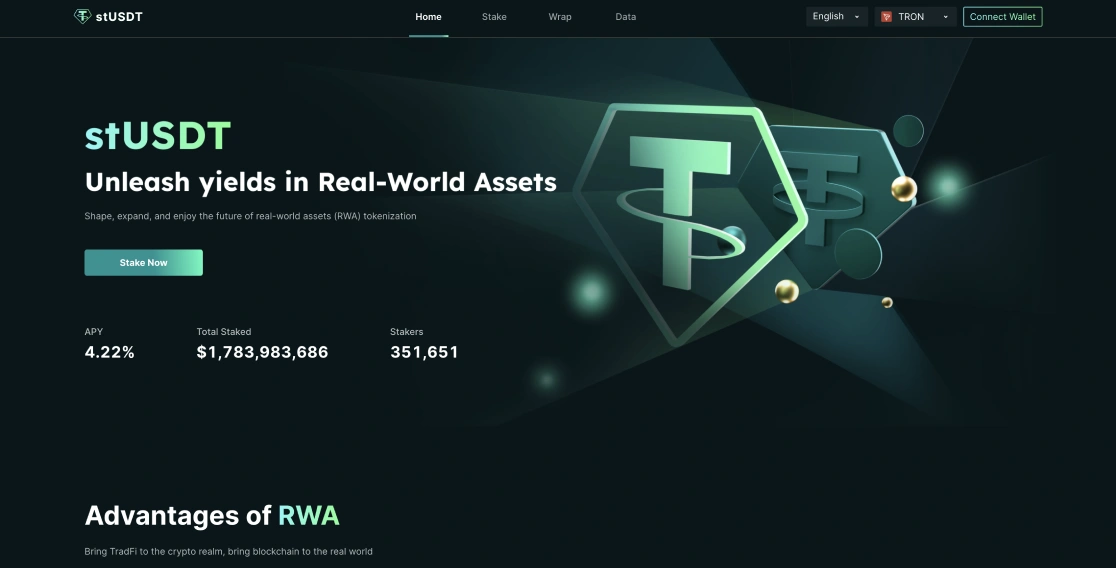What is stUSDT?

Summary: Staked USDT (stUSDT) allows you to stake USDT and gain exposure to real-world assets like U.S. Treasury bonds, potentially earning an annual yield of around 4.2%.
While it bridges traditional and decentralized finance using smart contracts, concerns about its governance and transparency, especially its associations with Justin Sun, warrant careful research before investing.
stUSDT is a specialized token that allows users to stake USDT for exposure to real-world assets like short-term government bonds, aiming to diversify crypto portfolios while offering competitive returns.
Supported Networks
Tron and Ethereum mainnet.
USDT Yields
stUSDT pays a 4.22% Yield.
Total Value Locked (TVL)
Over $1.7 billion.
What is Staked USDT (stUSDT)?
Staked USDT (stUSDT) is a token that lets you access real-world assets like short-term government bonds by staking your USDT on a platform managed by RWA DAO, a decentralized autonomous organization. By staking, you're not just holding USDT, you’re improving your crypto portfolio with diversification and potential yields. The platform uses smart contracts to ensure transparency and security, and it's available on both Ethereum and TRON networks.
What’s interesting about stUSDT is how it bridges traditional finance with decentralized finance. You get the liquidity of blockchain tokens while gaining exposure to stable assets like U.S. Treasury bonds. With a focus on transparency, stUSDT offers a solid option for investors seeking stable investment opportunities, providing an Annual Percentage Yield of around 4.2%

How Does stUSDT Earn Yield?
stUSDT generates yield by staking USDT and investing in real-world assets like U.S. Treasury bonds. The process works as follows:
- Smart Contracts Manage Investments: The platform utilizes smart contracts to oversee transparent investments in assets like U.S. Treasury bonds.
- Stake USDT for stUSDT Tokens: By staking USDT, you receive stUSDT tokens that represent your investment and entitlement to earnings.
- Investment in U.S. Treasuries: The pooled USDT is allocated by designated arrangers to purchase U.S. Treasury bonds, aiming for stable yields.
- Yield Distribution Through Rebase Mechanism: The platform adjusts the quantity of stUSDT tokens in your wallet to reflect earned yields, distributing returns automatically.
- Consistent 1:1 Exchange Rate: The exchange rate between USDT and stUSDT remains constant at 1:1, simplifying calculations and maintaining the value of your investment.

What is wstUSDT?
wstUSDT is the wrapped version of stUSDT, designed to enhance its compatibility with DeFi protocols that might not support stUSDT directly. In the crypto world, wrapping a token means creating a new token that mirrors the value of another asset, making it easier to use across different platforms.
Similar to stUSDT, wstUSDT allows you to earn yields through staking but offers extra flexibility for interacting with DeFi platforms like JustLend. Before diving in, make sure to do your homework, as both stUSDT and wstUSDT come with complex risks and governance structures.

Who Owns stUSDT?
stUSDT is an independent project that, according to a spokesperson from Tether, has no affiliation with Tether (USDT). The protocol operates on the TRON network and claims partnerships with several crypto ventures linked to Justin Sun, such as HTX (formerly Huobi), JustLend and TrueUSD (TUSD). On-chain data shows a significant amount of stUSDT associated with addresses controlled by Justin Sun, particularly within his HTX platform.
Despite its growth and the substantial assets it manages, stUSDT is under scrutiny regarding its governance and transparency. Concerns have been raised about its actual affiliations and the legitimacy of its claimed partnerships, especially after Tether publicly denied any relationship with the stUSDT protocol.
Is stUSDT Safe?
stUSDT's safety is debated due to its governance structure and unclear connections with major entities like Tether. The involvement of Justin Sun also raises concerns about potential centralized control.
For more transparent options, consider alternatives like the Spark Protocol by MakerDAO, which is known for its clear governance and reliable performance in DeFi. Always perform thorough research before investing.
Bottom Line
stUSDT provides a way to diversify your crypto holdings by staking USDT to access real-world assets like U.S. Treasury bonds, potentially earning about 4.2% annually. While it connects traditional and decentralized finance using smart contracts, there are concerns about its governance and transparency, particularly regarding its affiliations and control.
.webp)
Written by
Jed Barker
Editor-in-Chief
Jed, a digital asset analyst since 2015, founded Datawallet to simplify crypto and decentralized finance. His background includes research roles in leading publications and a venture firm, reflecting his commitment to making complex financial concepts accessible.

.webp)
%25201%2520(1).webp)
.webp)
.webp)
%2520(1).webp)




